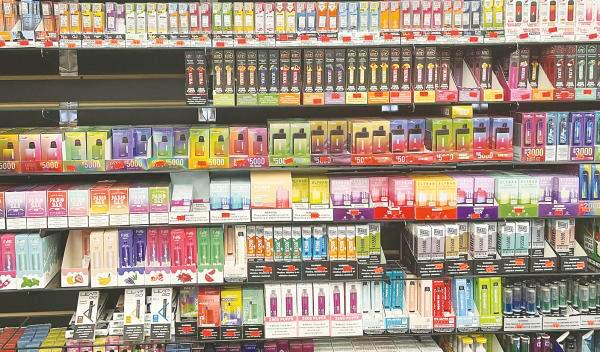LAST week, it was reported that Universiti Sains Malaysia’s National Poison Centre recorded a 30.6% increase in nicotine poisoning cases last year, marking a five-fold rise compared with the figures from 2019.
A significant portion of those affected were young people, especially teenagers aged between 15 and 19. They were found to be experiencing nicotine poisoning as a result of vaping and using e-cigarettes (commonly referred to as e-ciggies).
Symptoms reported ranged from drowsiness, diarrhoea, severe vomiting and abdominal pain to loss of consciousness, seizures and, in extreme cases, psychosis and hallucinations.
There have also been reports of illicit drug use involving e-ciggie liquids, a trend previously observed in neighbouring Indonesia. This occurrence is not entirely surprising as warnings had been issued.
Despite lacking legislation or regulations to oversee the distribution, sale and availability of vape and e-cigarettes containing nicotine, one year ago, the then Health Minister, Dr Zaliha Mustafa, signed an order to remove liquid or gel nicotine from the list of controlled substances under the Poisons Act 1952. This decision was made despite a rare unanimous decision by the Poison’s Board to reject the proposed action by the minister.
Consultation with the board is required by law before a minister can issue an order under that specific Act.
The proposal to remove nicotine used in vape and e-cigarettes faced opposition from numerous public health advocates and healthcare professionals, especially those specialising in tobacco control and nicotine addiction.
They argued that such drastic actions would cause significant harm and potentially result in permanent repercussions, potentially worse than smoking cigarettes. Despite these concerns and warnings being noted, they were not heeded.
The ramifications of this decision have been manifold. Nicotine vapes and e-cigarettes of various varieties and concentrations are now legally available and permitted for sale, not only to adults but also to young people and children.
Regulatory ambiguity has created a significant gap, leading to unregulated vaping.
The market is flooded with inexpensive vape disposables containing high concentrations of liquid nicotine, as international players from China, the US and the United Kingdom, along with the domestic e-cigarette industry, view Malaysia as a lucrative consumer market with enormous potential for new nicotine delivery devices, all without regulatory oversight.
The nicotine content in vape products sold in Malaysian retail shops and roadside stalls remains among the highest in the world.
Liquid nicotine in a single disposable vape device is available in concentrations ranging from 3% to 5%. Vape disposables with 5% nicotine are readily accessible in the country for as little as RM10-20. Such high concentrations are not found in countries with regulations and taxes on vape products.
For example, in the United Kingdom, Europe, the US and Indonesia, where e-cigarettes are regulated and taxed, the maximum strength permitted for retail sale ranges between 20mg (2%) and 30mg (3%). Any higher concentration requires a prescription.
A person usually inhales between one and 3mg of nicotine from a single conventional cigarette. Today, many retail outlets do not bother stocking up vape devices or liquids with less than 5%.
Encouraged by the policy decision, over the past year, vape and e-cigarette manufacturers and retailers have aggressively targeted, marketed, advertised, distributed and indiscriminately sold their wares openly to all, including young consumers.
They have even sponsored sporting, fitness, health and lifestyle events, which is prohibited by law for tobacco and cigarette companies. As a result, data shows an increase in the number of teenagers who have never been smokers but are now vaping and using e-cigarettes.
According to data, women, specifically young women who were previously a small fraction of cigarette smokers, now constitute 30% of vape consumers.
Children as young as 10 are becoming addicted to nicotine. Tragically, some individuals have become disabled, and there have been cases where teenagers have lost their lives due to vaping-related issues. Furthermore, certain individuals and political parties have ridiculed public health advocates and healthcare professionals on social media, downplaying their concerns.
They suggested that the Control of Smoking Products for Public Health Bill would soon be passed, and criticised those who opposed the delisting of nicotine for being unreasonable and impatient.
However, the Bill was delayed and referred to a parliamentary special select committee. It would be around November or December before Parliament would pass the Bill.
While gazetted in February, this law still requires regulations to be put in place, which are anticipated to be available in June.
Until then, nicotine vaping and e-cigarettes will remain unregulated. The cost of delisting nicotine without appropriate regulations in place are expected to be severe, with significant potential harm.
The expected tax revenue collected from vape and e-cigarette sales seems insignificant in comparison.
Any person appointed as health minister carries a heavy burden of responsibility and a duty of care to safeguard the health of the population.
No minister should be allowed to reject or ignore evidence-based recommendations from healthcare professionals. Leadership is crucial, and the courage to do what is right must make a difference.
The Control of Smoking Products for Public Health Act will pave the way for introducing regulations such as plain packaging, bans on point-of-sale displays, restrictions on e-cigarette flavours and other measures aimed at preventing and controlling nicotine addiction while reducing underage smoking and vaping.
This legislation marks a crucial step towards finally regulating nicotine vape and e-cigarettes.
Unfortunately, the generational endgame policy has been shelved. The government must consider increasing the existing excise duties on cigarettes and other tobacco products which have remained unchanged since 2015.
Malaysia spends an estimated RM16 billion annually treating smoking-related illnesses such as cardiovascular disease and lung cancer. Increasing the excise tax rate to RM0.77 per stick, equivalent to 61% excise tax on the retail price, will generate additional tax revenue of RM771.8 million.
The new law is a chance to do things differently and help shape a better and healthier future for all Malaysians.









